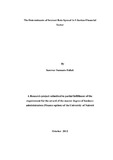| dc.description.abstract | Financial reform predicts achievement of efficiency in the intermediation process and
reduced transaction costs, which is proxied by a narrowing wedge between the
lending and deposit rates. Liberia‘s experience shows a rise in interest rate spread
during the financial reform and subsequent financial liberalization process, which
suggests the failure to meet the prerequisites for successful financial liberalization.
Interest rates were liberalized amidst much pressure, declining economic growth,
financial instability as a result of years of civil crisis, the failure to sustain fiscal
discipline and lack of proper sequencing of the shift to use monetary policy tools. The
objective of this study was to examine the determinants of interest rate spread in the
financial sector of Liberia and methodology the study was designed using various
factors that are used to determine the gap between lending and deposit interest rate. At
the micro level, this research results show that when the profit margin is threatened,
banks sustain a widening spread. The accumulation of non-performing loans results
from a weak legal system and a poor business environment that squeezes the profit
margin, and banks respond by increasing the lending rate. Policy actions also affect
the spread. An asymmetric response is indicated with the foreign exchange rate where
lending rates increase with the foreign exchange rate between the Liberian dollars and
United dollars rate, and become sticky downward when the foreign exchange lower
between the two currencies.
The Central Bank of Liberia responded to the widening gap in interest rate by
publishing the interest rates on both deposits and lending that must be maintained by
Commercial banks but in the absence of ensuring that factors that lead to the widening
gap are addressed, some commercial banks could not adhere to the published interest
rates by the Central Bank. The Central bank also indicated that it is contemplating
adjusting the gap between lending and deposit interest rates, thereby reducing general
and substandard provisions by one (1%) percent and five (5%) percent respectively.
The CBL also indicated that it intends to introduce a stimulus loan package of Five
Million United States Dollars (US$5,000,000) to commercial banks at the rate of three
(3%) percent for lending to Liberian business at the rate of not more than eight (8%)
percent per annual. | en |

